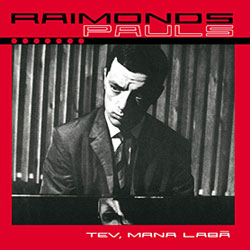
Raimonds Pauls. The name alone has a great meaning to just about every Latvian, whether they are living in Latvia or elsewhere. Ask a Latvian what their opinion of the man is and you are bound to get a full spectrum of responses. Beloved by many, detested by just as many, Pauls has been by far the most famous figure in Latvian music in the past 50 years.
Pauls is also probably the most prolific composer of the time as well, having released albums by the boatload throughout the years. And in all styles as well: film music, jazz music, music for theatre, Christmas music and just about everything else you could think of. Of course, with that kind of output, there was bound to be some material of lower quality. (The Sapņu pīpe record, anyone? I get bad memories just thinking of that one.) One of the main reasons Pauls was able to release so much material was his good standing with the government at the time, something that few other artists had.
Tev, mana labā was released in 1969, and was Pauls’ very first record. The album had long been out of print, but MICREC—recognizing Pauls’ very large fan base and the historical significance of this record—re-released it on compact disc at the beginning of 2001. And, as a bonus, this CD includes four additional tracks that weren’t on the original album, but had been separately released on a 7-inch vinyl record.
The first time I sat down to listen to this CD I didn’t know what to expect. I knew many of these songs, but didn’t know what they would sound like, as I hadn’t heard them in years. However, as soon as the first track, the song "Tev, mana labā," started playing, a wave of memories started flowing back. My parents had this record when I was much younger and I listened to it constantly. Although I have since aged (but maybe not matured) and my musical tastes have changed, there are still many great songs on this album.
Pauls’ music can be hard to classify at times. "Lounge music" seems to be the most common description, and it fits many of the songs here. Most of the songs are backed up by the REO (Rīgas estrādes orķestris), and feature Pauls’ usual suspects on vocals, including Ojārs Grīnbergs, Nora Bumbiere and Margarita Vilcāne. Pauls had a great interest in jazz as well, a rather different sound in Latvian music of that day.
This release contains many of Pauls’ best-known songs. Among fans, "Mežrozīte" remains his most beloved song. MICREC’s Web site ran a poll on the public’s favorite Pauls song and "Mežrozīte" won hands down. And it is a really beautiful song, with lyrics by A. Krūklis, about a forest rose that continues to grow and bloom throughout the years.
Another favorite of mine and of the general public is the song “Papu, saki mammai pats." It is a song about a conversation between a father and his daughter, who wants to get married to some guy. Of course, both father and daughter are deathly afraid of Mom, so neither wants to talk to her about this (sounds like a typical Latvian mother!). But there are wedding bells at the end of the song, so presumably Mom was okay with the whole thing. The song is infuriatingly catchy, and you will find yourself singing it for a week after hearing it.
Other famous songs include "Kur tu esi" and "Dziesma nenosalst." The latter is a song about wishing to hear the old cradle songs that had been sung in distant childhood, and features some very pretty harpsichord work and backing vocals by a women’s ensemble.
The sound quality of the CD is exceptional. MICREC has done a great job restoring the audio to the highest CD quality. The packaging is also very well done, with very interesting commentary and history about the recording of this album, as well as pictures. The only disappointment is the fact that the lyrics were not included.
Some songs are too “lounge” for me and make me reach for the CD remote so I can skip those tracks. A good example is "Cik labi, ja Tu blakus man." Even as a 7-year-old kid, I couldn’t listen to it the whole way through. It’s a song best left for hotel bars.
One thing struck me as particularly odd. With Pauls having the clout that he does, you would figure he would have had at least a better picture of himself on the front cover! The picture is truly dreadful, with Pauls adopting his best "I am a very serious socialist" pose.
If you’re going to have one Raimonds Pauls album in your collection, this would be the one. It has some of his best work on it, as well as some of his most famous songs. At times the record does show its age, but there are many timeless classics here that will undoubtedly remain popular in the Latvian world for years to come. Love him or hate him, you have to respect the man for his musical ability, and Tev, mana labā is one of the best examples of Raimonds Pauls’ ability to make music.
Details
Tev, mana labā
Raimonds Pauls
MICREC, 2001
© 1995-2024 Latvians Online
Please contact us for editorial queries, or for permission to republish material. Disclaimer: The content of Web sites to which Latvians Online provides links does not necessarily reflect the opinion of Latvians Online, its staff or its sponsors.




